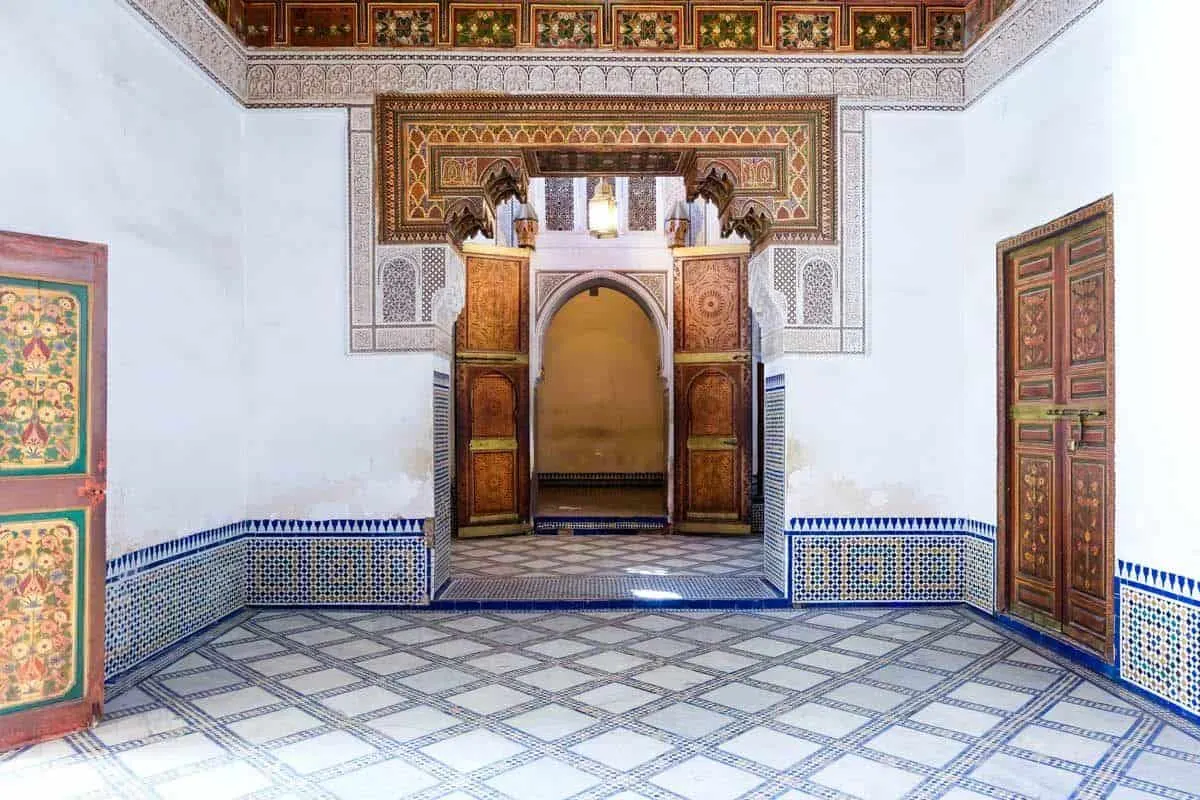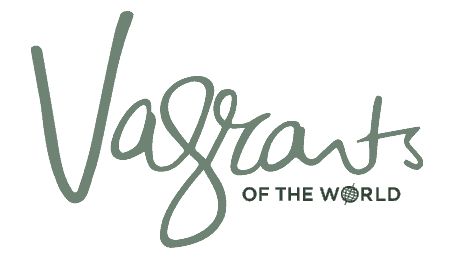Marrakech has a reputation for overwhelming first-time visitors with its heady atmosphere and sensory overload. We have put together a guide on the best things to do in Marrakech so you don’t get overwhelmed by Morocco’s most popular tourist destination.
A city with its own chaotic rhythm, Marrakech also has a surprisingly good dose of razzle and dazzle.
Unlike Fez where cultural authenticity is a concept held dearly by locals. Or, Casablanca, a city that surprises with a refreshingly modern and cosmopolitan side of Morocco, Marrakech can feel more like a movie set. A Disney-esque version of its former self.
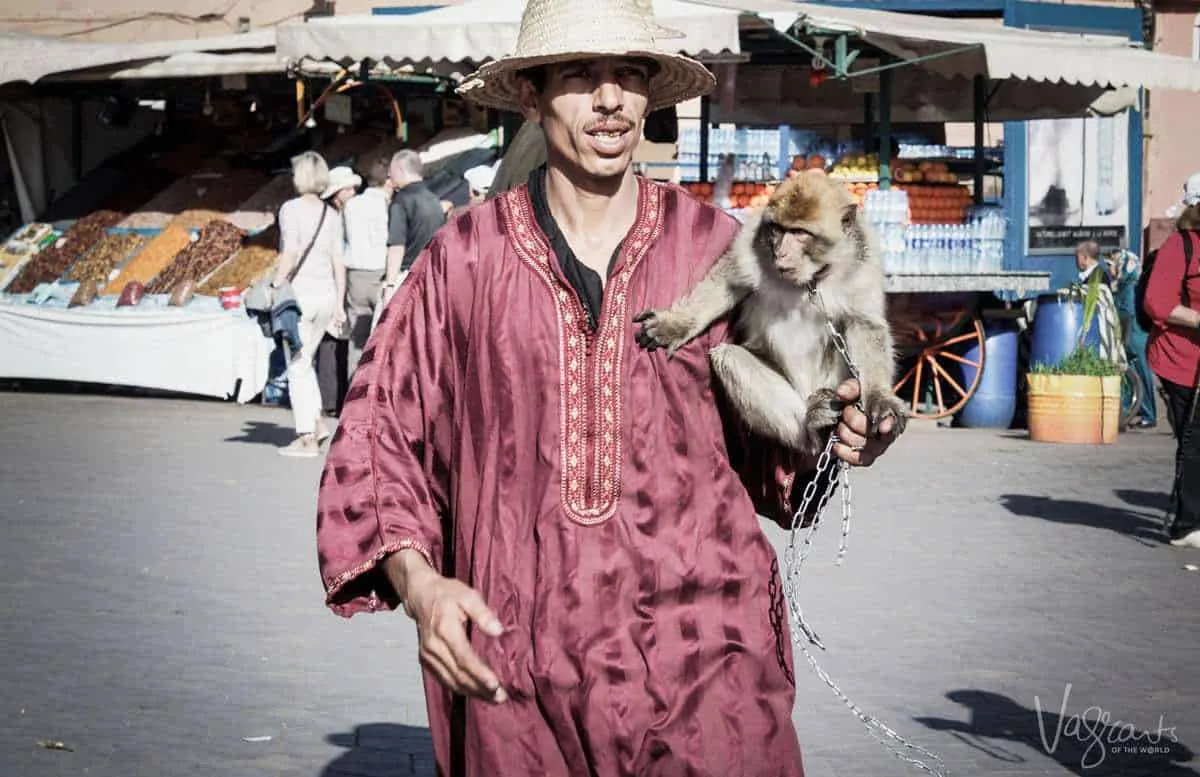
In places, Marrakech is what you would expect from an Arabian Nights or Indiana Jones movie. Right down to the snake charmers and potentially menacing touts in the darkened tangle of lanes of the souks and markets. Regardless of the tourist trappings, there are so many wonderful things to do in Marrakech.
Plan Your Perfect Morocco Itinerary
A guide to The Best Places to Visit in Morocco loaded with useful Morocco travel tips.
How much does a trip to Morocco cost? Plan your itinerary with this Morocco Budget Breakdown.
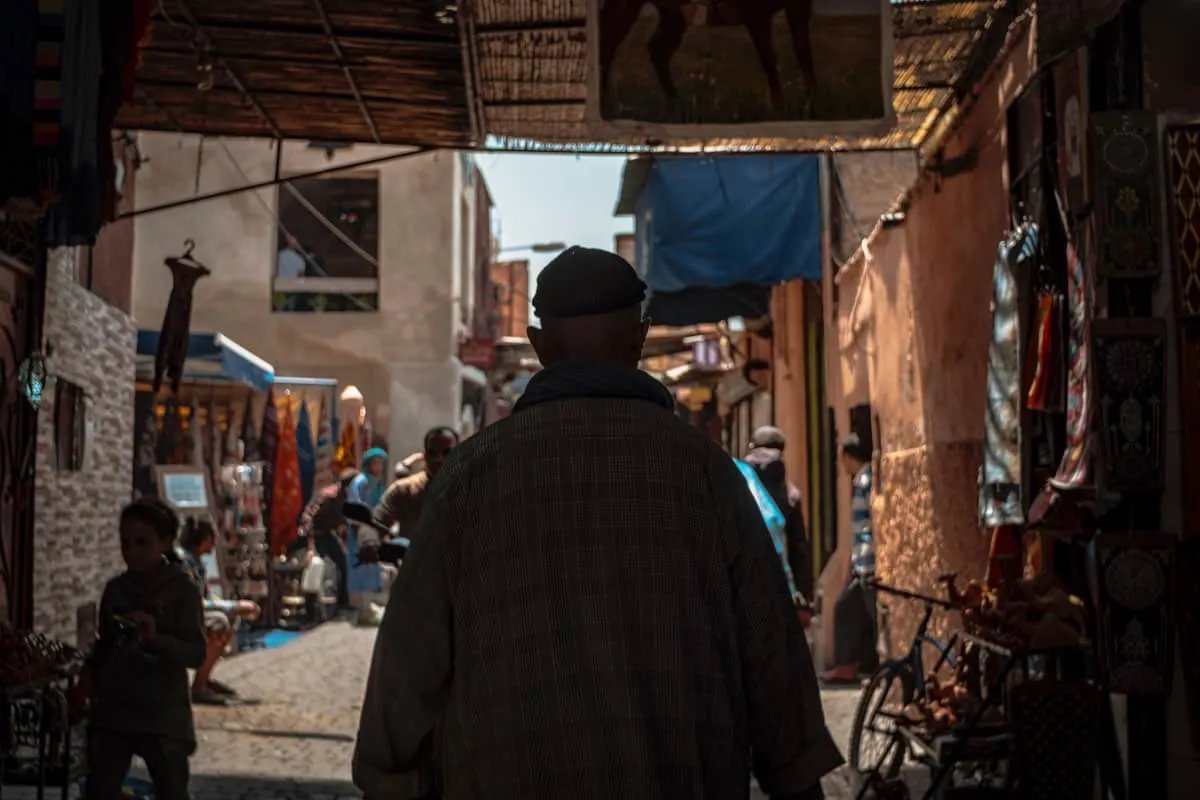
About Marrakech
The name Marrakech, or Marrakesh originates from Berber meaning “Land of God”. It is the third-largest city in Morocco after Casablanca and Rabat.
Get to Know Morocco Better: We’ve rounded up the best books to read before you visit Morocco that will share insight into the countries culture, history and stories.
Where is Marrakech
Marrakech has an enviable location with the contrasting landscapes of the snow-capped Atlas Mountains and the Sahara Desert within easy reach. It is the capital city of the mid-south-western region, Marrakech-Safi.
Marrakech is 150 miles south of Casablanca, 200 miles southwest of the Moroccan capital Rabat, 360 miles southwest of Tangier and 350 miles southwest of the famous blue city of Chefchaouen.
Thanks to its proximity to some of Morocco’s biggest tourist drawcards, it is one of the most popular places to visit in Morocco.
We have an extensive list of useful travel tips for Marrakech here. But these few tips will get you on your way to start planning your trip.
How Long to Spend in Marrakech
Marrakech is not a big city, but there is a lot to do and see. We would recommend three to four days to enjoy the best Marrakech attractions in the city centre without rushing.
Day Trips From Marrakech
Marrakech is a great base for accessing some of Morocco’s best attractions such as the Atlas Mountains and the desert. You can find some of the best day trips from Marrakech here for a completely different side to Morocco.
Six to seven nights in Marrakech is a good amount of time if you wish to explore some of the great day trips in the area.
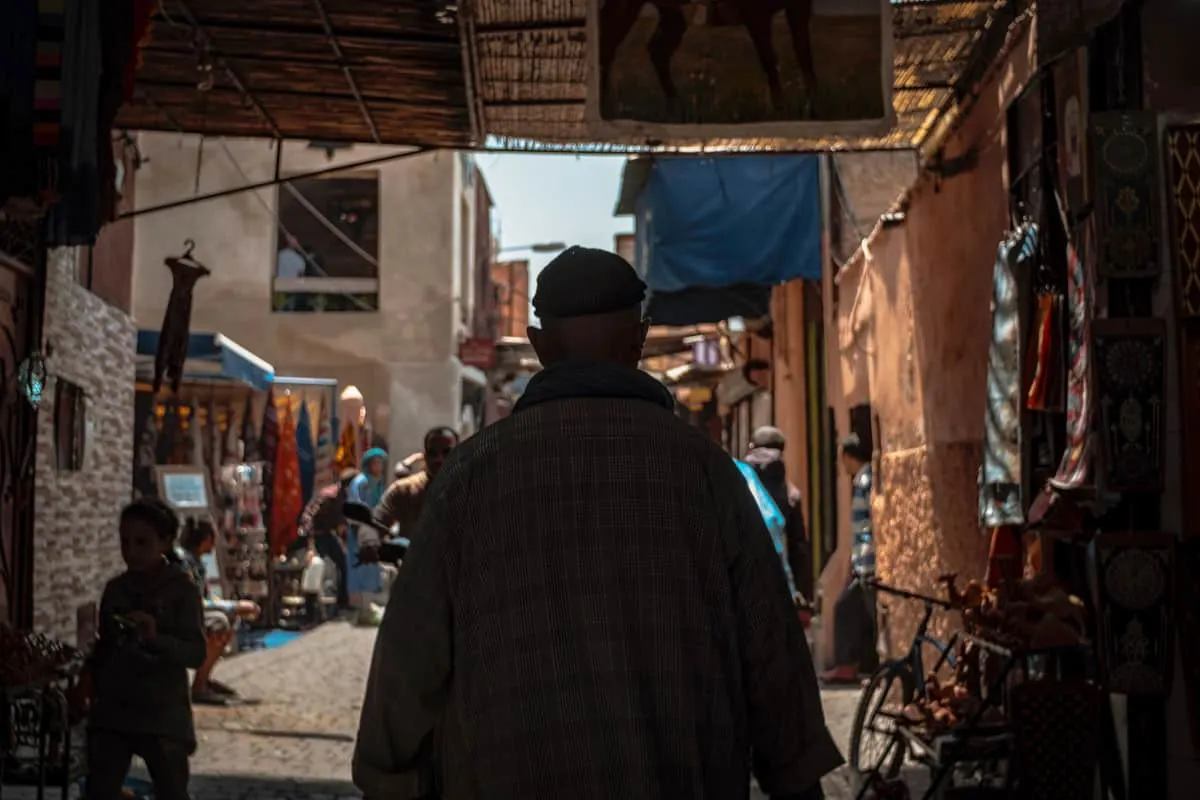
Tips For Travelling in Morocco
What to Wear in Morocco: Remember, Morocco is a Muslim country, so it is important to dress appropriately (conservatively) to avoid any unwanted attention.
Read More on How to Dress Like a Local to ensure you blend in rather than stand out.
Morocco Packing List: See our full Morocco Packing List. A complete guide on what to wear and what to pack for Marrakech and Morocco for any season.
Is Marrakech Safe
Marrakech is generally safe but petty crime is prevalent, especially in tourist areas.
Always keep money, personal belongings and luggage locked and secure, even in hotel rooms and always be aware of pickpockets.
Remember, Morocco is a Muslim country so please be mindful and respect their Islamic customs and laws.
Stay Safe in Morocco: We’ve got you covered with great travel safety tips and the best anti-theft travel gear so you can relax while you travel.
Old and New Marrakech
Like Fez and Tangier; Marrakech is divided into two. The historical centre and the new European styled modern city centre – Gueliz or Ville Nouvelle.
Experience the extremes of medieval life in Oldtown Marrakech and North African luxury and commercialism in Gueliz, New Marrakesh.
What to do in Marrakech for First Time Visitors to Morocco
Sightseeing in New Marrakech
New Town – Guiliez; in stark contrast to the historical centre boasts clean, modern restaurants, fast food chains and big brand stores.
A legacy of the French protectorate of Morocco, areas outside the original city walls has a distinctly Parisian feel, with wide boulevards, beautiful gardens and booming cafe culture.
And much like Paris, Gueliz is not without its luxury hotels and high-fashion brand-name boutiques. It’s a great contrast to the hustle of old town with a chill vibe that provides a breath of fresh air.
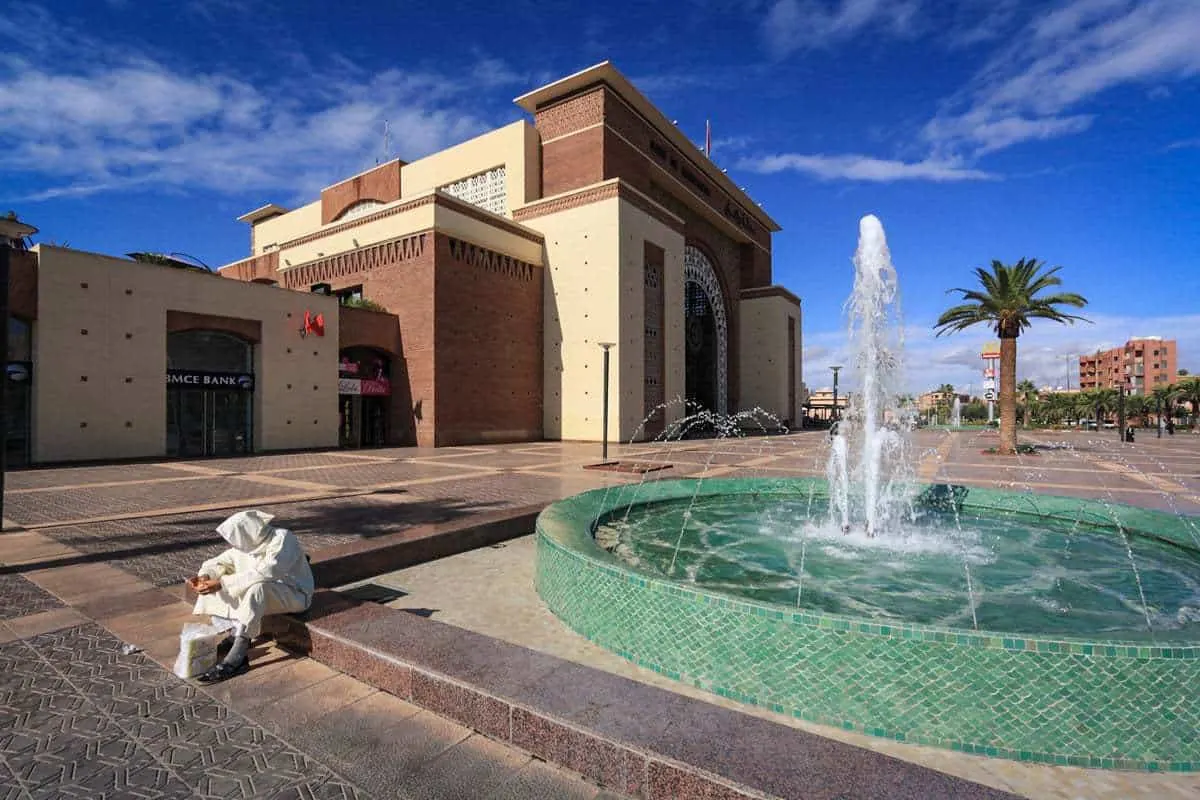
Visit the Yves Saint Laurent Museum
As if to reinforce the reputation Marrakech has for luxury and designer shopping, a new museum dedicated to French fashion designer Yves Saint Laurent has opened in the Gueliz district.
If you are interested in visiting the Yves Saint Laurent Museum, it is located at Rue Yves Saint Laurent 40090 Marrakech.
- YSL Museum Opening Hours: Daily from 10:00 am to 6:00 pm except for Wednesdays.
- Be aware the last admission is at 5:30 pm and the busiest times are between 10 am and 2 pm.
- Entry Price: YSL Museum Marrakech tickets are 100DH pp (~ $10 USD).
See the Famous Marrakech Gardens
Jardin Majorelle
One of the most visited places in Marrakech is the Jardin Majorelle and museum. The Jardin Majorelle Gardens was a lifelong labour of love for famous French Orientalist artist Jacques Majorelle.
The two and a half acres of magnificent gardens took nearly 40 years to complete from 1923. Featuring a Cubist villa designed by Frech architect Paul Sinoir, the property was the residence of the artist and his wife until their divorce in the ’50s.
Jardin Majorelle Yves Saint Laurent
The property was purchased and restored by Yves Saint Laurent and Pierre Bergé in the ’80s. The garden and villa complex is now open to the public. The villa houses the Islamic Art Museum of Marrakech, the Berber Museum and, the Musee Yves Saint Laurent. Yves Saint Laurant’s ashes were scattered in the garden after his death in 2008.
As with Musee Yves Saint Laurent, the gardens are located at Rue Yves Saint Laurent, Marrakech.
- Jardin Majorelle Opening Hours:
- October 1 – April 30: 8 am – 5:30 pm
- May 1 – September 30: 8 am – 6 pm
- During the month of Ramadan: 9 am – 5 pm.
- Entry Price: 70 DH for the garden and 30 DH for the museum.
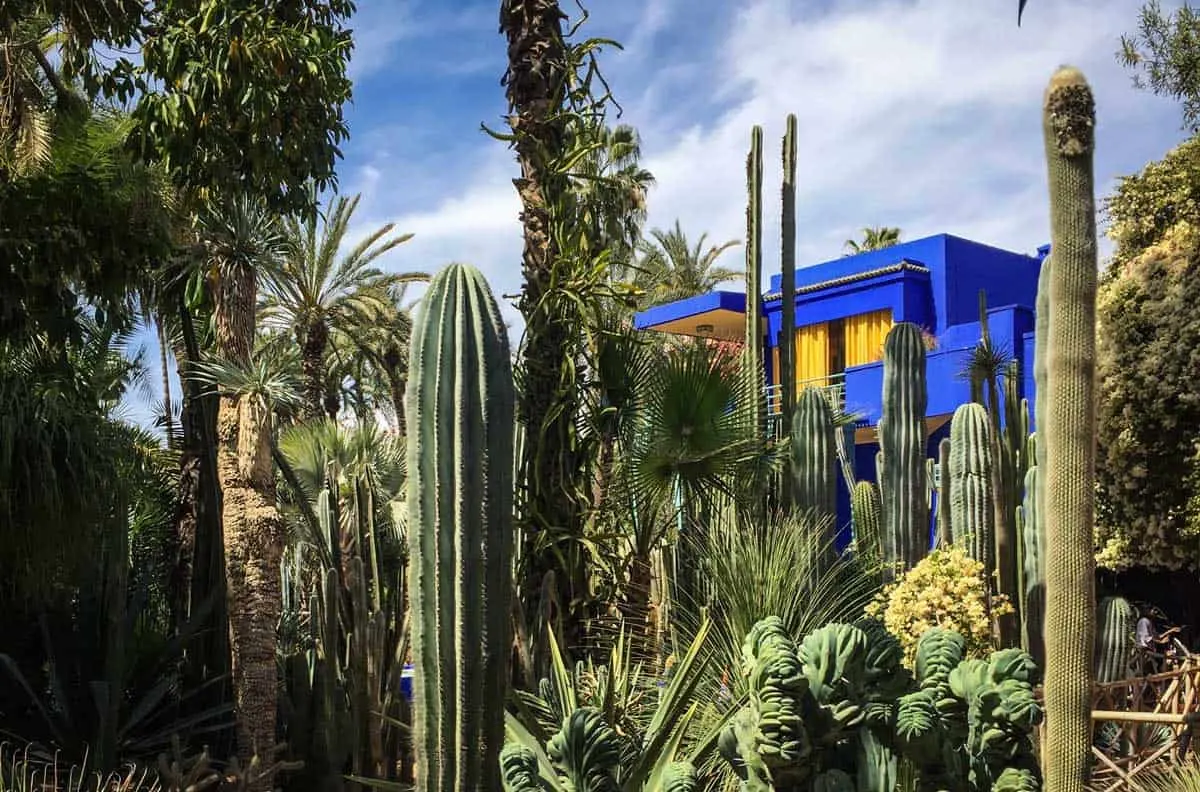
The Agdal Gardens
Located on the grounds of the Royal Palace, the Agdal Gardens are four hundred hectares of botanic gardens including orange, lemon, fig, apricot and pomegranate orchards, as well as lines upon lines of olive groves dating back to the 12th century.
The name Agdal means ” Walled Meadow”. After starting as an orchard, the garden was later renovated and walled by the Saadi Dynasty.
Some say they come away from the Agdal Gardens a little disappointed. There is no set walking trail as such nor is there a museum or tourist centre on the site.
However, the views over the gardens certainly do impress as does the main interest point of the gardens – the highly sophisticated irrigation system.
The Agdal Gardens are a remarkable example of the architectural and landscaping skills of the time. A network of underground channels brings water all the way from the Atlas Mountains and the Ourika Valley to a vast water basin.
The underground irrigation systems then feed the orchards all year round from pools and large lagoons on the grounds. The largest lagoon is called the ‘Tank of Health’, a favourite swimming spot of the King’s troops.
Together with the medina of Marrakech and the Menara Gardens, the Agdal Gardens are listed as a UNESCO World Heritage Site.
The Agdal Gardens are three km south of the Medina. Approx a half-hour walk or 15–20 DH in a Petit Taxi.
- Agdal Gardens Opening Hours:
- Closed on Sundays & Wednesdays
- All Other Days: 7:30 am – 1 pm
- The gardens may be closed at any time depending on what is happening in the palaces.
- Free Admission
The Menara Gardens
Located west of Marrakesh at the gates of the Atlas Mountains is the Menara Gardens. Known as the little sister to the Agdal Gardens, Menara gardens were also established in the 12th century by the Almohad dynasty.
The name Menara translates as “Lighthouse” from the pavilion with its small green pyramid roof (Menzel). The name is not a reference to any history of an actual lighthouse but to the religious significance of the building.
Similar to the Agdal Gardens, Menara Gardens also has a large basin using a sophisticated network of underground channels which also serves to irrigate the surrounding groves and orchards.
- Menara Gardens Opening Hours: Monday – Sunday: 6 am – 6 pm
- Entry: 10 DH pp
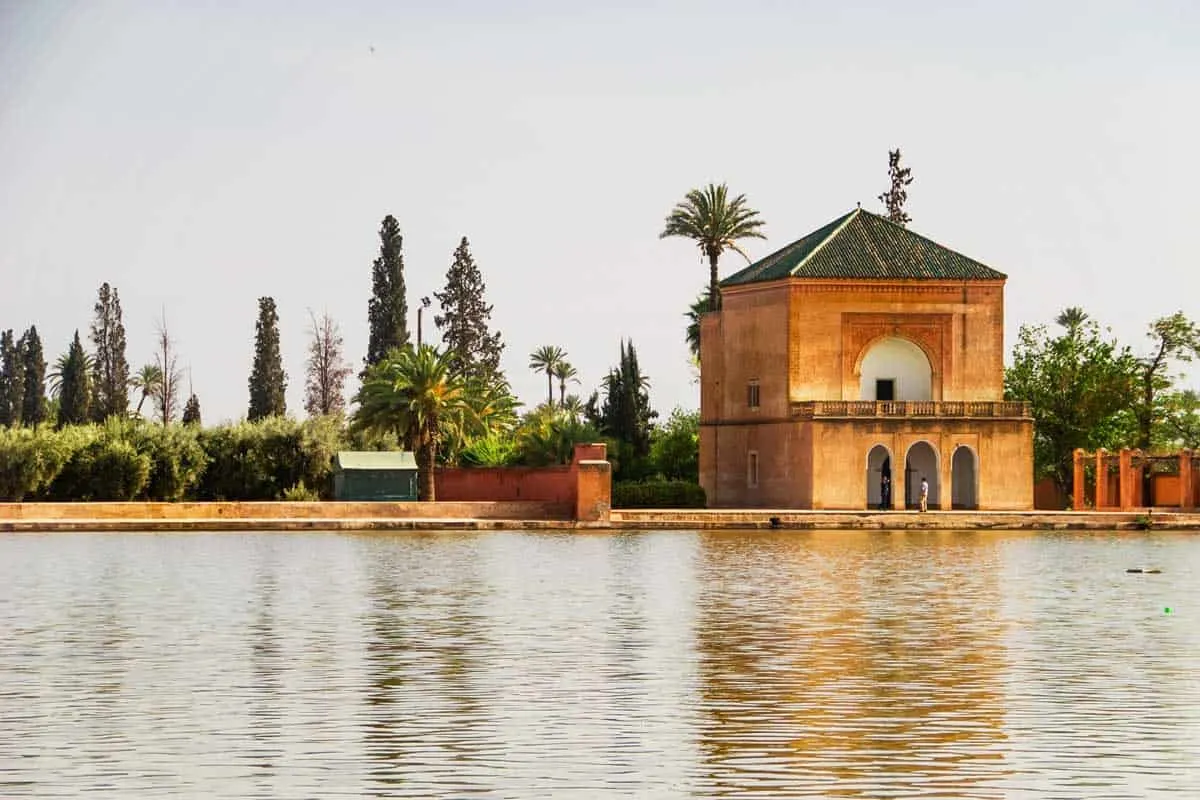
Koutoubia Mosque
The Koutoubia Mosque is the largest Mosque in Marrakech, famed for its magnificent minaret. It is known by many names including Jami’ al-Kutubiyah, Kutubiyya Mosque, Kutubiyyin Mosque, and the Mosque of the Booksellers.
The mosque is located about 200 metres from the Djemaa el Fna Souk. Non-Muslims are not allowed entry to the mosque, but you can admire it from the outside.
The mosque is incredibly photogenic at night when it is all lit up. It’s no wonder it’s one of the most popular things to do at night in Marrakech.
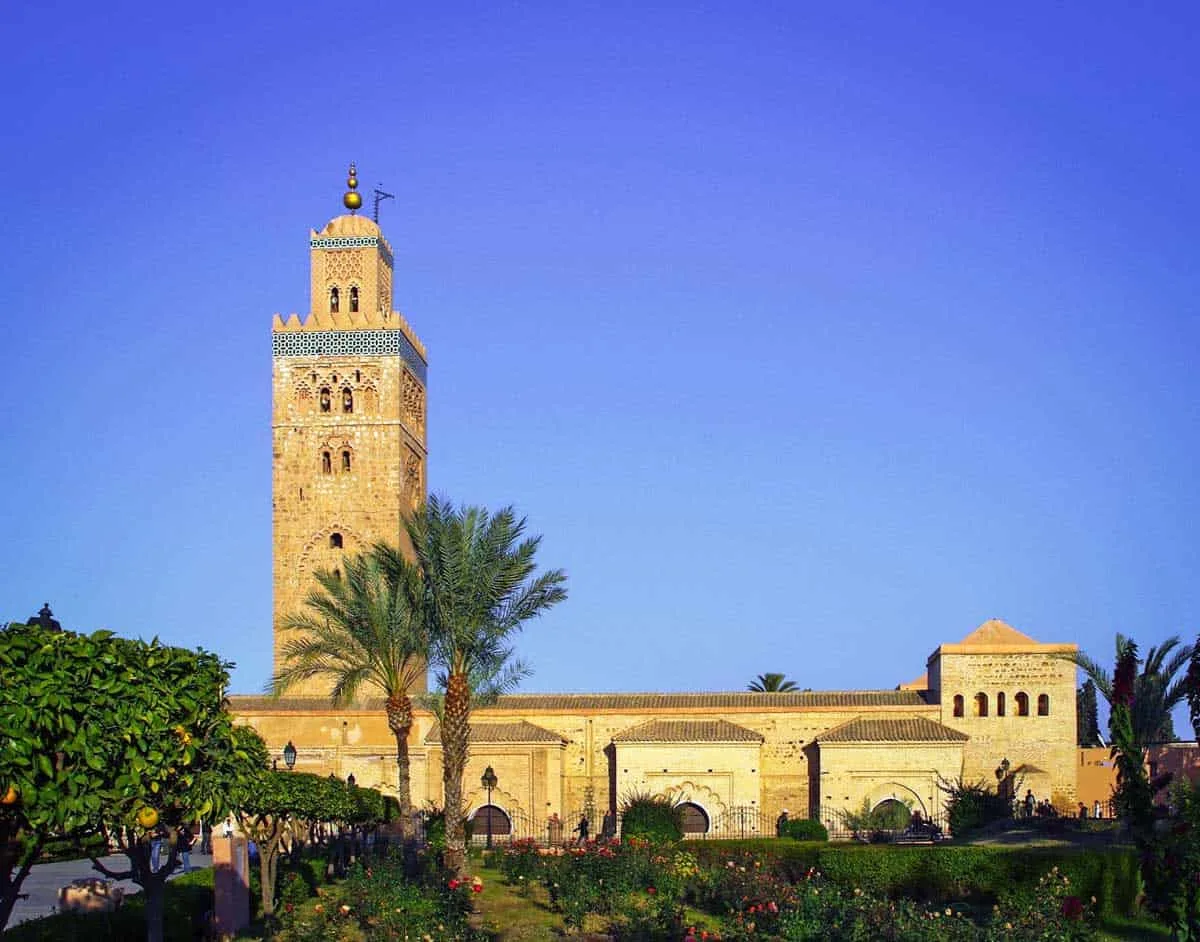
Explore & Adventure in Marrakech Old City
Within the historical city, the Medina, a twisted maze of intertwining passageways is a whirlwind of modern trade in a medieval setting. A place where scents and stenches will entice and startle you at will. It’s a Marrakech “Must See”.
Djemaa el Fna (Central Square)
The Old City centre is also where you will find Djemaa el Fna, the large central square brimming with markets, hotels, and cafes where tourists, locals, and vendors congregate.
Here you will see snake charmers, storytellers, street performers, hawkers and plenty of vendors selling freshly squeezed Moroccan orange juice.
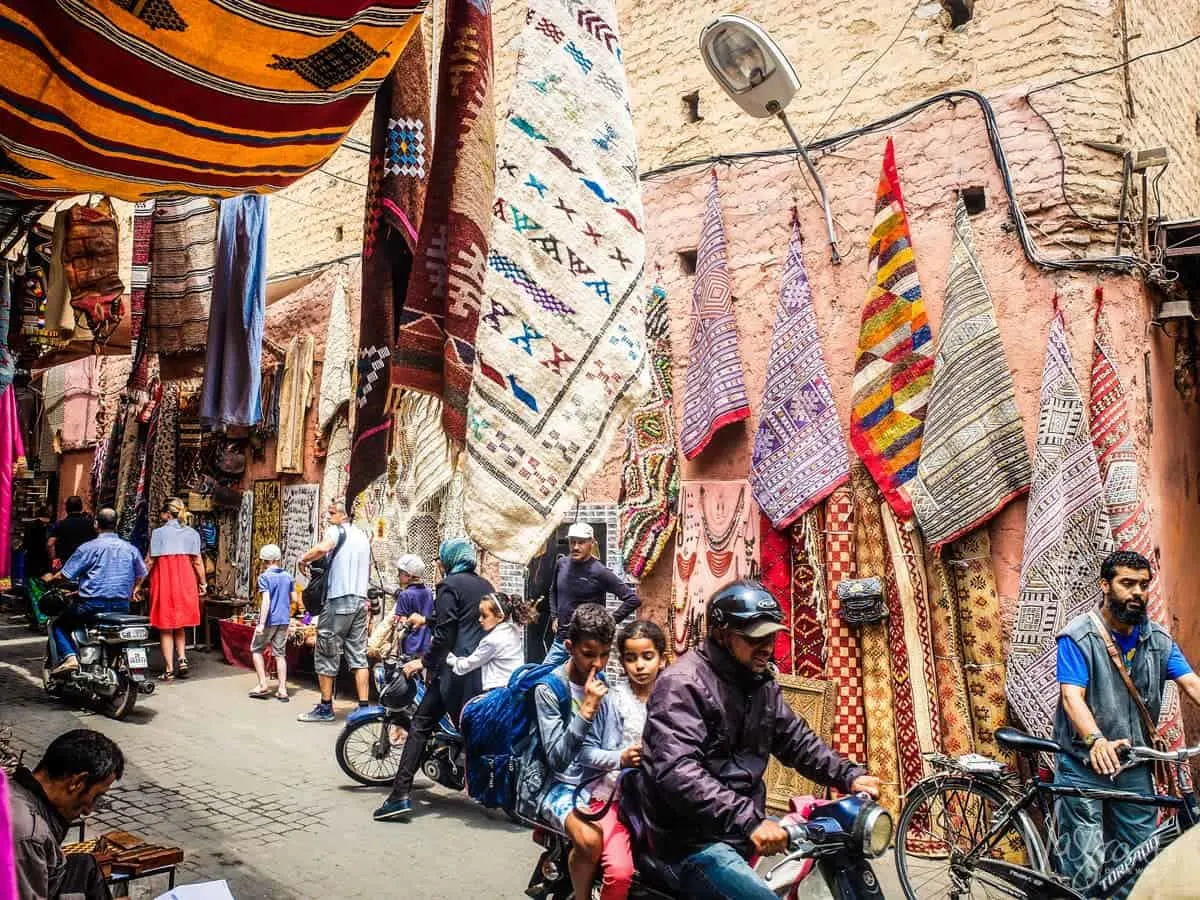
Witness the Exotic in Jemaa el Fna Square
Jemaa el-Fna is the pulse of Marrakech. The city’s main square has been a hub of trade and entertainment since 1050 AD. The name Jemaa el-Fna has many translations, one being “gathering and congregation area”.
Other translations give credit to the ongoing mystique and theatre of the square throughout the ages including “assembly of the dead”, referring to public executions that took place on the plaza.
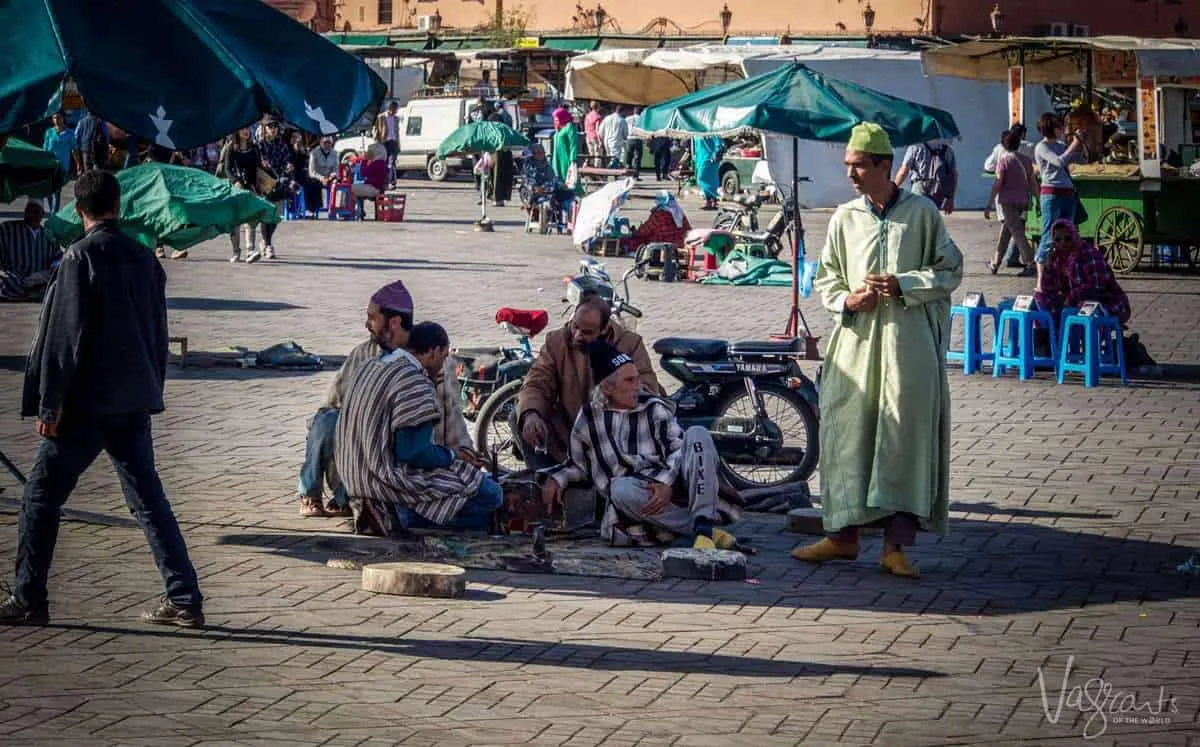
Each day, by mid-morning the is square abuzz with markets, typical Moroccan food vendors and an array of exotic exhibitions and street performers. A carnival that dazzles late into the evening when the Jemaa el Fna night market is in full swing.
It is thanks to this nightly display of traditional storytellers, musicians and performers, UNESCO declared the square a Masterpiece of the Oral and Intangible Heritage of Humanity.
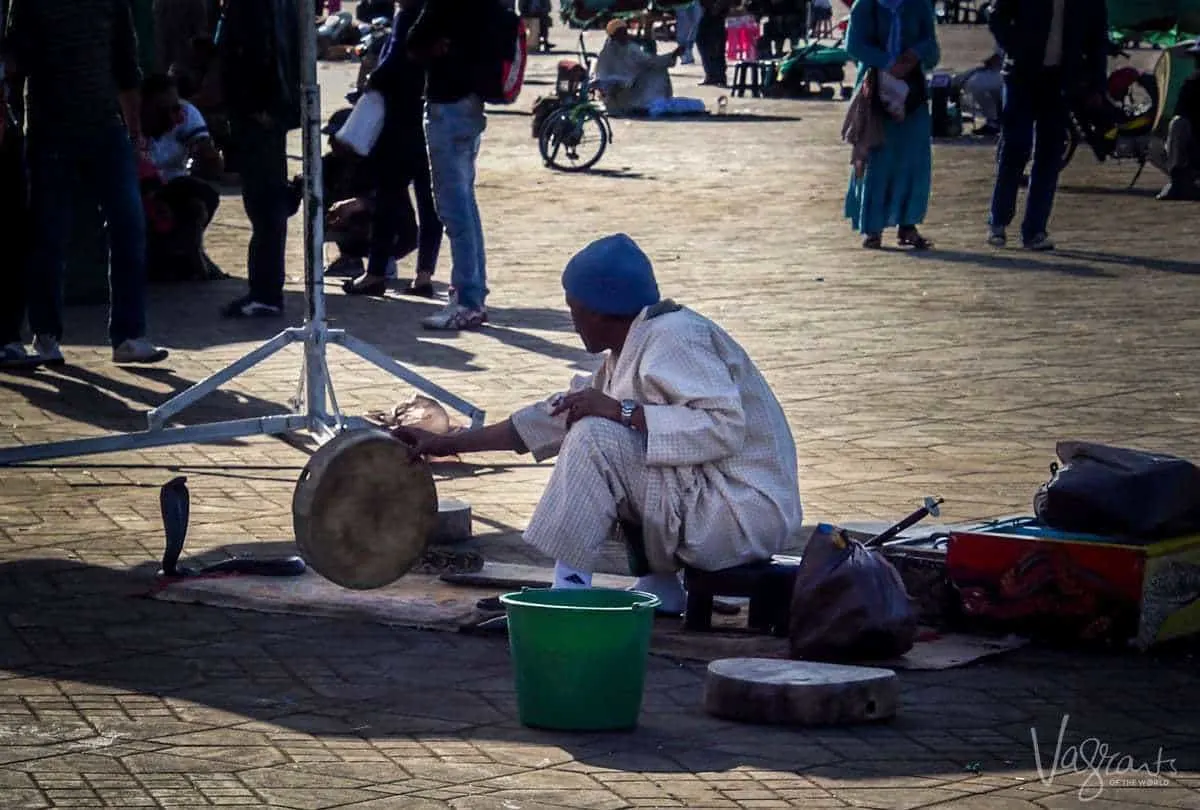
Beware the Darker Side of Jemaa el Fna Square
However, there is a cruel irony that the preservation of the squares historic and cultural identity has given rise to a darker side of Marrakech. Monkeys kept in cages or led around on chains, and snake charmers with less than ethical practices are a common sight.
For around 20 DH you can have your photo taken with a real-life vulture on your shoulder. Unsavoury characters will harangue you to buy while scammers and pickpockets work for the crowds.
Keep Your Belongings Safe in Marrakech: We’ve got the best Pickpocket Proof Clothing for travel that doesn’t sacrifice style for safety.
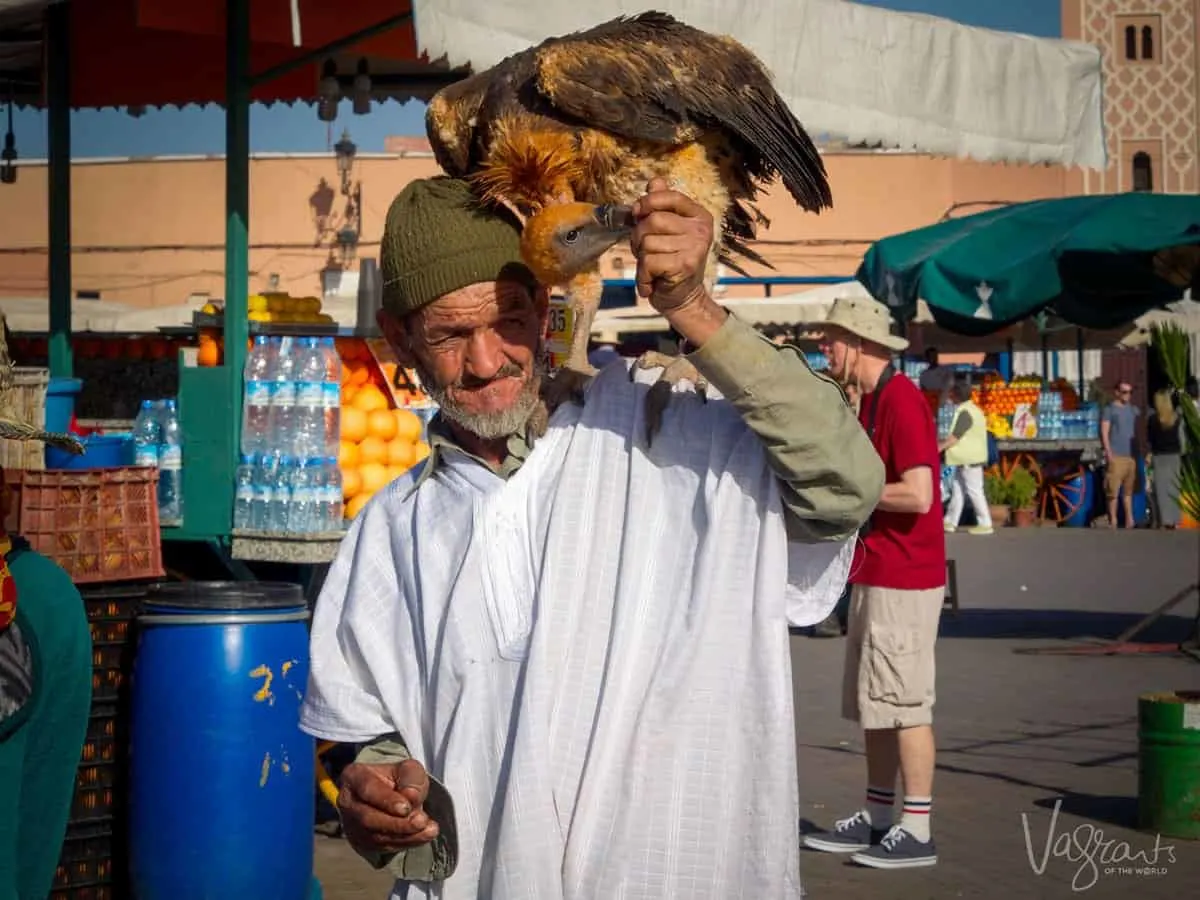
Enjoy the Sights From A Cafe Rooftop Terrace
Sadly, the constant hassle and hustle is the side of Marrakech that tends to leave people with a love-hate relationship with the city.
And for this reason, for many, one of the best ways to enjoy Jemaa el-Fna square is looking down on the madness, sipping mint tea from one of the many rooftop terrace cafes. Set yourself up at any of Marrakech’s rooftop restaurants for a birdseye view of the colour and chaos that is Marrakech.
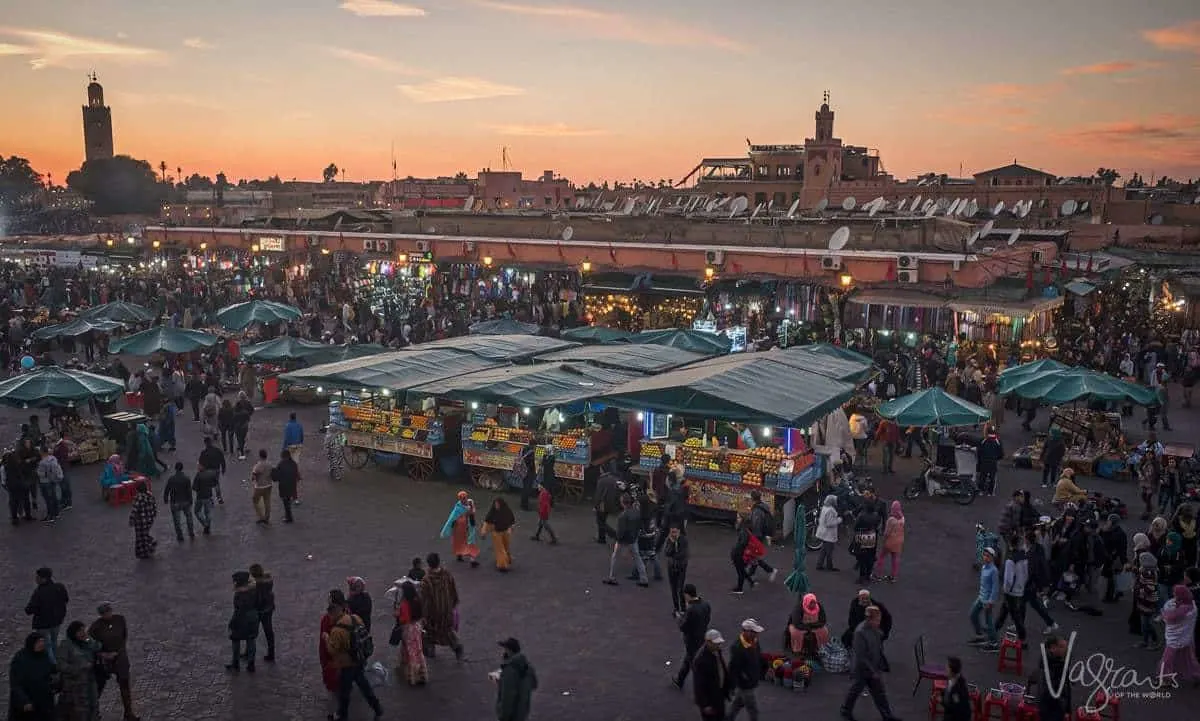
Lose Yourself in the Marrakech Souks
A Moroccan souk is one of those “must-sees” in Morocco experiences and the souks of Marrakech certainly don’t disappoint. It’s also one of the most exciting things to do for free in Marrakech.
The souks run like tentacles from the central madness of Jemaa el-Fna Plaza. It is in these ancient marketplaces where you will find the business end of Marrakech.
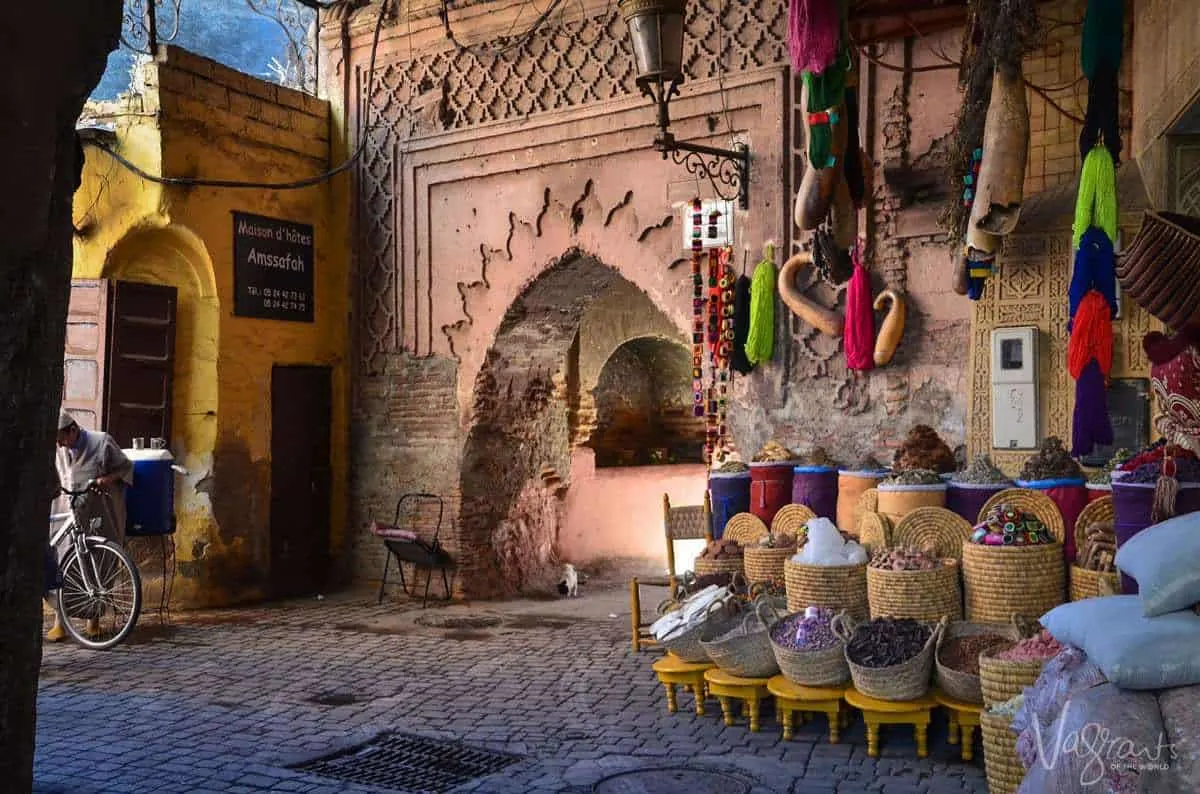
Winding lane-ways clogged with people, donkeys, and countless small businesses. Deep in the souk is the place to experience day to day life in Marrakech.
Whether you’re shopping for clothes, shoes, handicrafts, or food, you’ll find a street or an alleyway for everything.
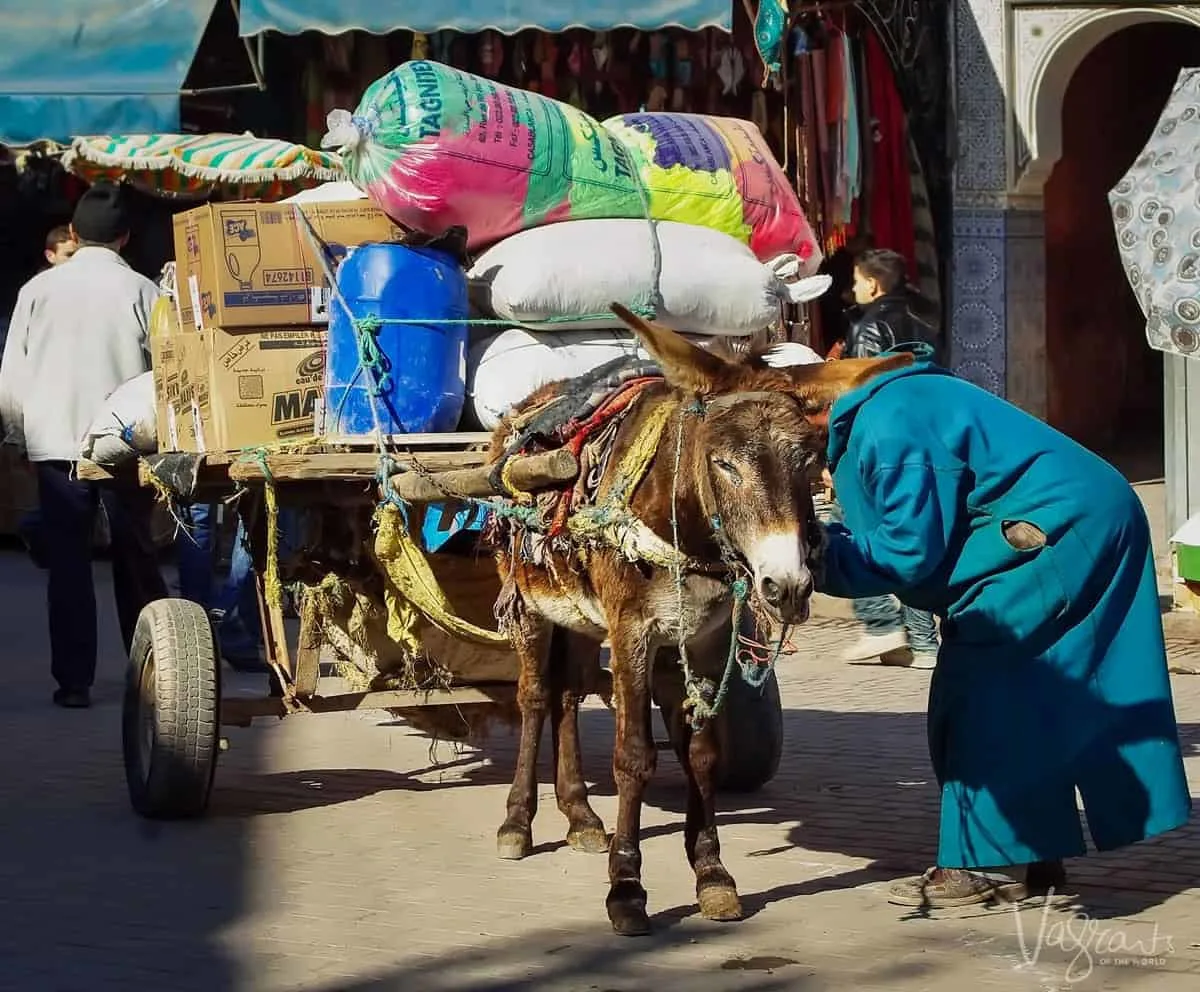
The Marrakech marketplace is the largest traditional market in Morrocco. Visitors can get lost for hours in the confusion of streets and lanes.
While this can be an intimidating prospect for first-timers; you are best to give in to the knowledge you will invariably get lost. Getting lost is part and parcel of the Medina experience. Just relax and explore, you will eventually find your way out. You’ll always find somewhere to stop for some mint tea to catch your breath.
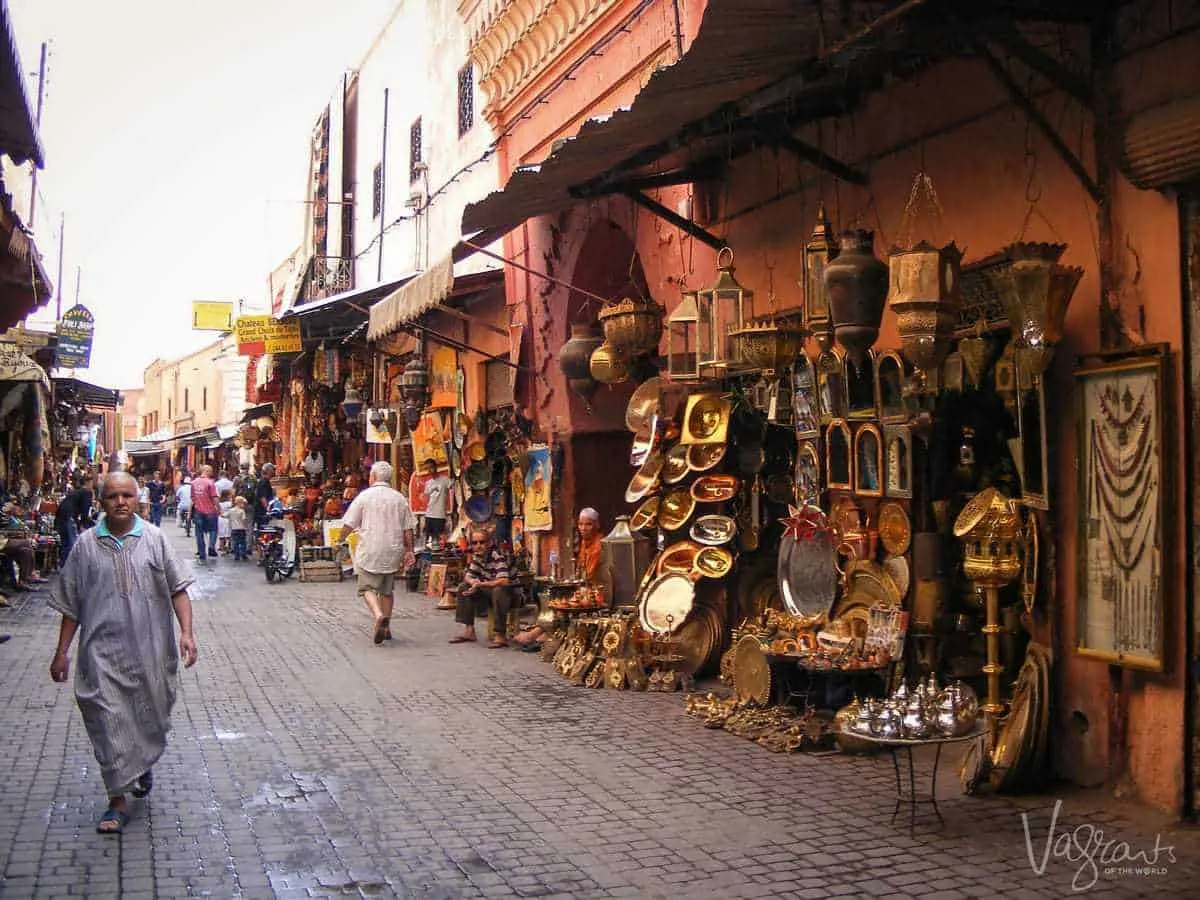
Shopping in Marrakech Souks
Shopping in Marrakech is more than just an exercise in retail therapy. It is a fun experience if you follow a few simple guidelines. If you are planning to buy something in the Marrakech souks, be prepared to haggle.
Haggling in Marrakech
Prices will usually start quite high. Sometimes they will be absurdly high to see what they might be able to get away with, but don’t walk away. Shop owners are expecting you to haggle.
A good starting point is around 60% of the asking price, especially if they quote you a ridiculous price to start. Keep the bargaining friendly even if they do try to fleece you. This helps to soften the vendor and hopefully get a better deal.
If you are looking to make a substantial purchase, ask at your hotel or do some research on what a typical price range for that item may be. Then you know what your bargaining parameters are.
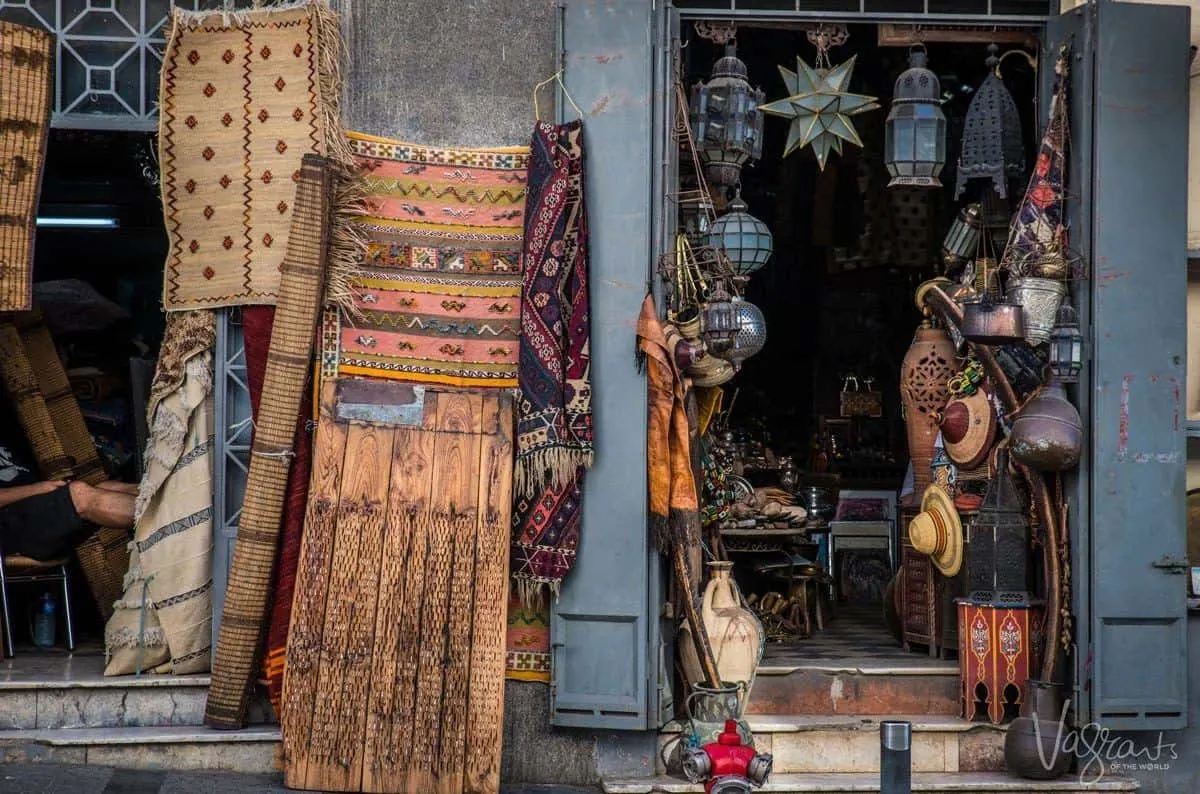
Visit the Tannery
While the tannery scam we talk about in our tips for visiting Marrakech is one to look out for, it doesn’t mean you have to miss the tannery altogether.
There are traditional tanneries in several cities in Morocco. Many think the 11th-century Chouara tanneries in Fez are a more worthwhile visit than the one in Marrakech. But if you aren’t heading to Fez, the Marrakech tannery still makes an interesting visit.
If you do visit the tanneries on your own; ask your hotel or some other trusted source for directions in advance or use a good city map of Marrakech. Be wary of any offers of help by “friendly” men on the streets and look like you know where you are going – even if you don’t.
If someone offers to guide you on a tannery tour; as with everything in Morocco, agree on a price beforehand.
Hire a Guide for a Tannery Tour
You can hire a local guide for 2 – 6 hours for as little as $30 USD to show you the local side of Marrakech including the medina and tannery. Some people feel this takes the stress out of being hassled by touts and you get to see Marrakech from a local perspective.
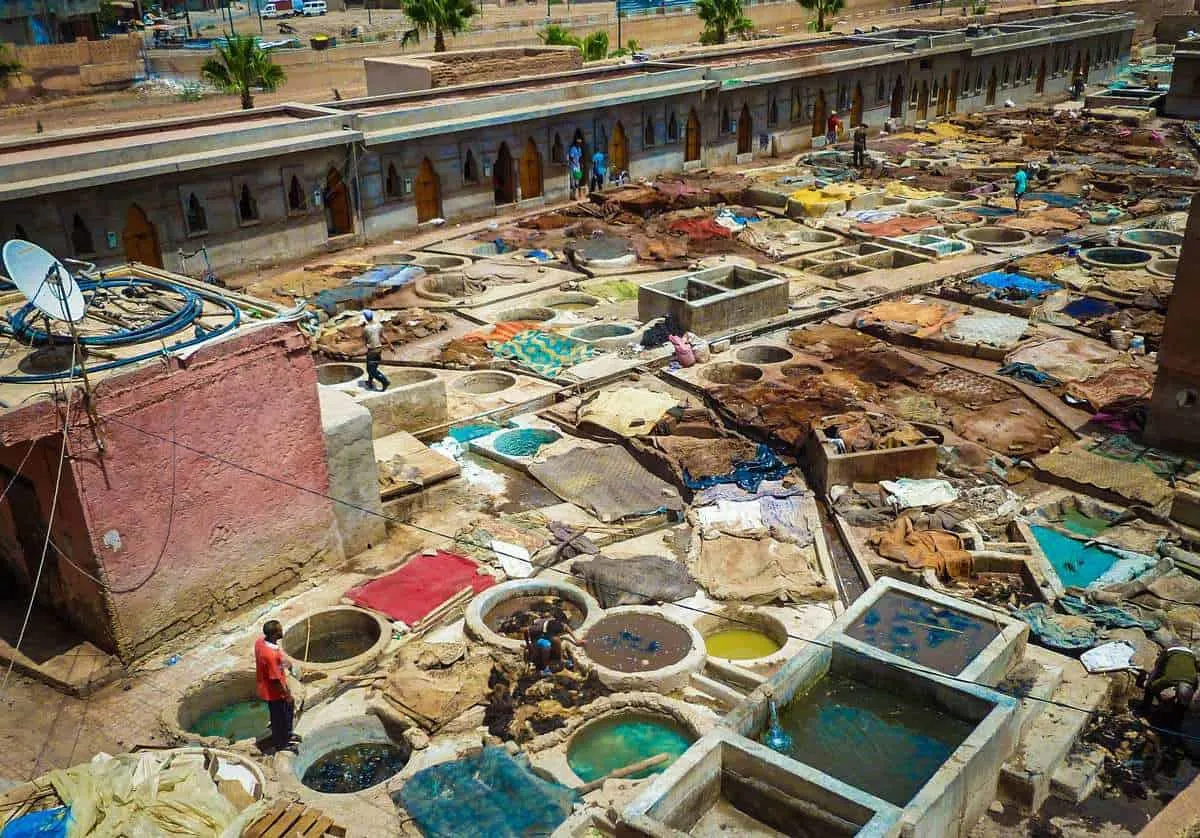
Souk Place des Épices (Spice Souk)
Slaves and grains were once sold in this open-air square in the heart of the souks. Today, Place des Épices is a colourful and fragrant display of basketry, herbs and, of course, spices.
Place des Épices is a haven for those interested in Moroccan cuisine. You can shop at traditional spice merchants for many aromatic spices, including ras al hanout, a fragrant mix of more than a dozen carefully selected spices.
You can also take a cooking class, shop at designer artisan shops or grab a bite at world-famous cafes such as Café des Épices or sleek restaurants like Nomad with a modern twist on the traditional and stellar views over the medina.
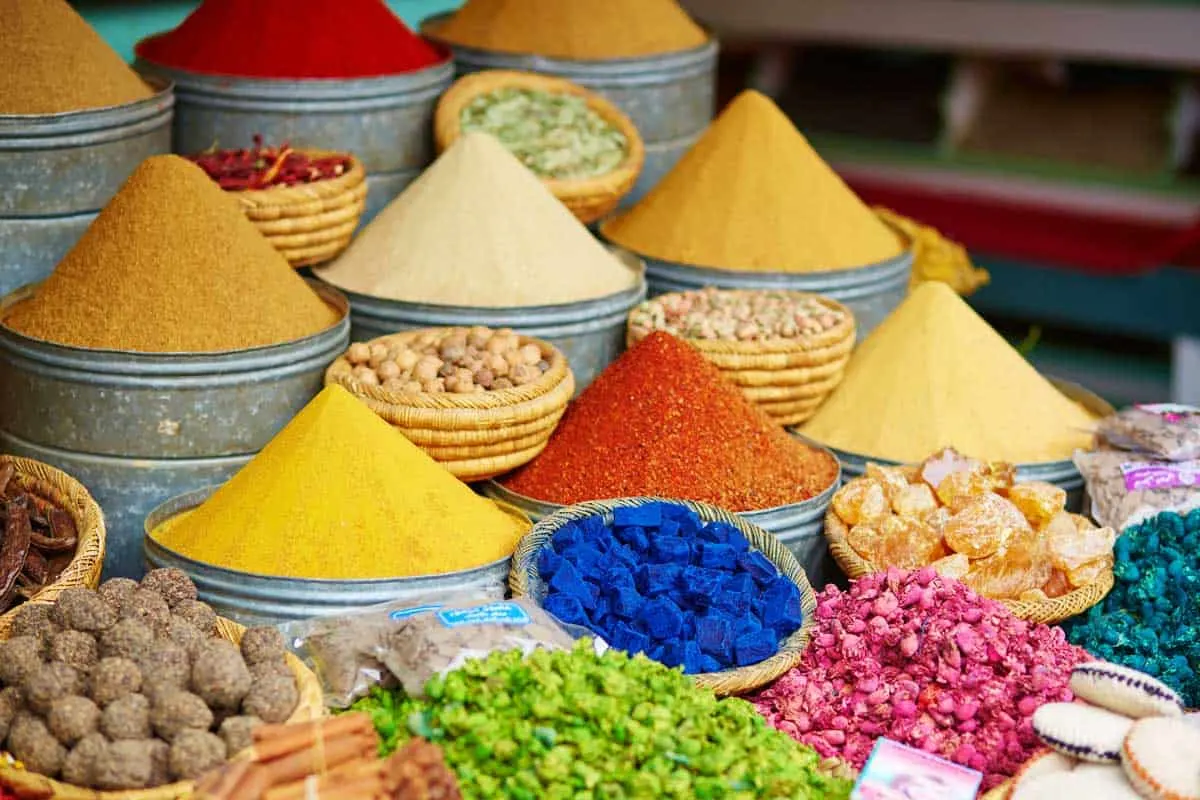
Take a Cooking Class
Learn the history of Moroccan food and the distinctive cooking style at a Moroccan cooking class. You will also learn about the blends of spices used in different dishes and the importance of spices in Moroccan culture. These are some of the cooking classes available in Marrakech, all with a different focus.
Tagine Cookery Class With a Local: 4 hours. Learn to cook authentic Moroccan tagines. Shop for ingredients at a souk, learn about the uses of herbs and spices and how to cook a traditional Moroccan meal with a local chef. See here for class details.
Cooking Class in a Historic Riad: 4 hours. Prepare a traditional Moroccan home-cooked meal at a small-group cooking class held in a historic Marrakech riad. The menu consists of only fresh, simple ingredients and spices, so you’ll be able to reproduce the menu in your home kitchen. See here for cooking class details.
Farm to Table Moroccan Cooking Class: 5 hours. Experience a unique way to cook a traditional Moroccan tajine in an authentic setting. On this farm to table class, you will visit a local market, choose your fresh ingredients, cook a flavorful dish you can replicate at home, and learn about traditional Moroccan culture. See here for the full class and tour details.
Ancient Sights and Museums
If your interest lies in visiting the Marrakech museums, The Ben Youssef Madrasa Islamic college, Badi Palace and Bahia Palaces, El-Mansoura Mosque or the Saadian Tombs, you may want to consider hiring a guide or taking a walking tour.
There is little information available at many of the sites, or little in English. A guide will help to provide some context.
Saadian Tombs
The final resting place of the rulers and members of the Saadi Dynasty, the Saadian Tombs, sealed for centuries were rediscovered in 1917.
While Saadian Sultan Ahmed al-Mansour Eddahbi spared no expense on his final resting place, a magnificent mausoleum decorated with bright tiles, Arabic calligraphy, and intricate carvings, he also constructed beautiful memorials to honour the lives of those close to him.
He built lavish mausoleums with imported Italian marble and gold, zellige tilework, and intricate woodwork. He created a resting place of beauty. Those who held the sultan’s greatest favour were buried closer to the centre of the complex. Others were buried throughout the extensive gardens of fragrant orange trees.
It is not surprising this serene place of incredible beauty is one of the most popular things to see in Morocco.
The Saadian Tombs are located just outside of Marrakech on Rue de la Kasbah, next to the Koutoubia Mosque
- Saadian Tombs Opening Hours: Daily: 9 am-4.45 pm
- Entry Price: 10DH
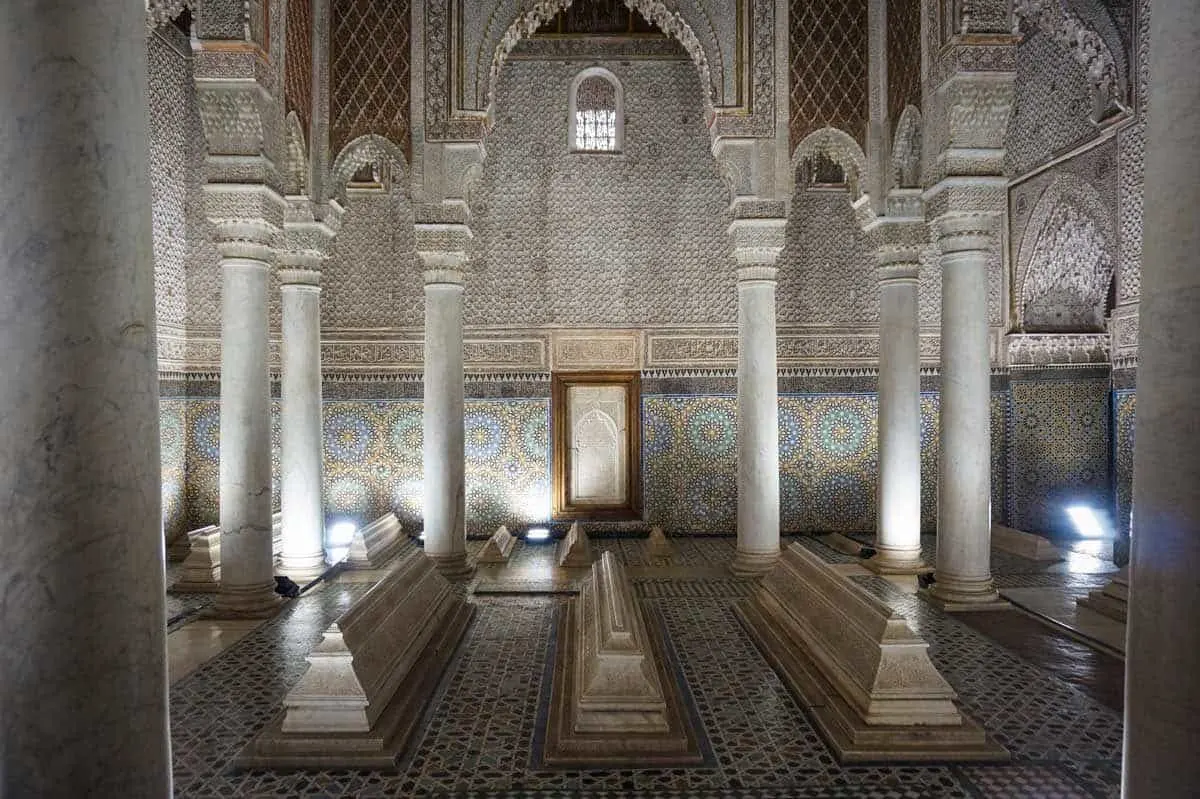
Ben Youssef Madrasa
A Madrasa is a place of education. The beautifully preserved 14th-century former Islamic theological college Ben Youssef Madrasa was once the largest in North Africa and one of the most splendid.
A stunning representation of Moroccan architecture, the school is affiliated with the nearby Ali ben Youssef Mosque. The college was once home to over 900 students; all living in the 130 tiny dorms arranged around the central courtyard.
Over time, the madrasa gradually lost its students to its rival college Medersa Bou Inania in Fez despite upgrades and renovations.
Regardless, the old seminary still manages to impress from the great courtyard to the richly decorated prayer halls, and after six centuries, the Madrasa is one of the most important attractions in Marrakech.
- Opening Hours of Ben Youssef Madrasa:
- Summer: 9 am-7 pm
- Winter: 9 am-6 pm
- Entry Price: 20DH
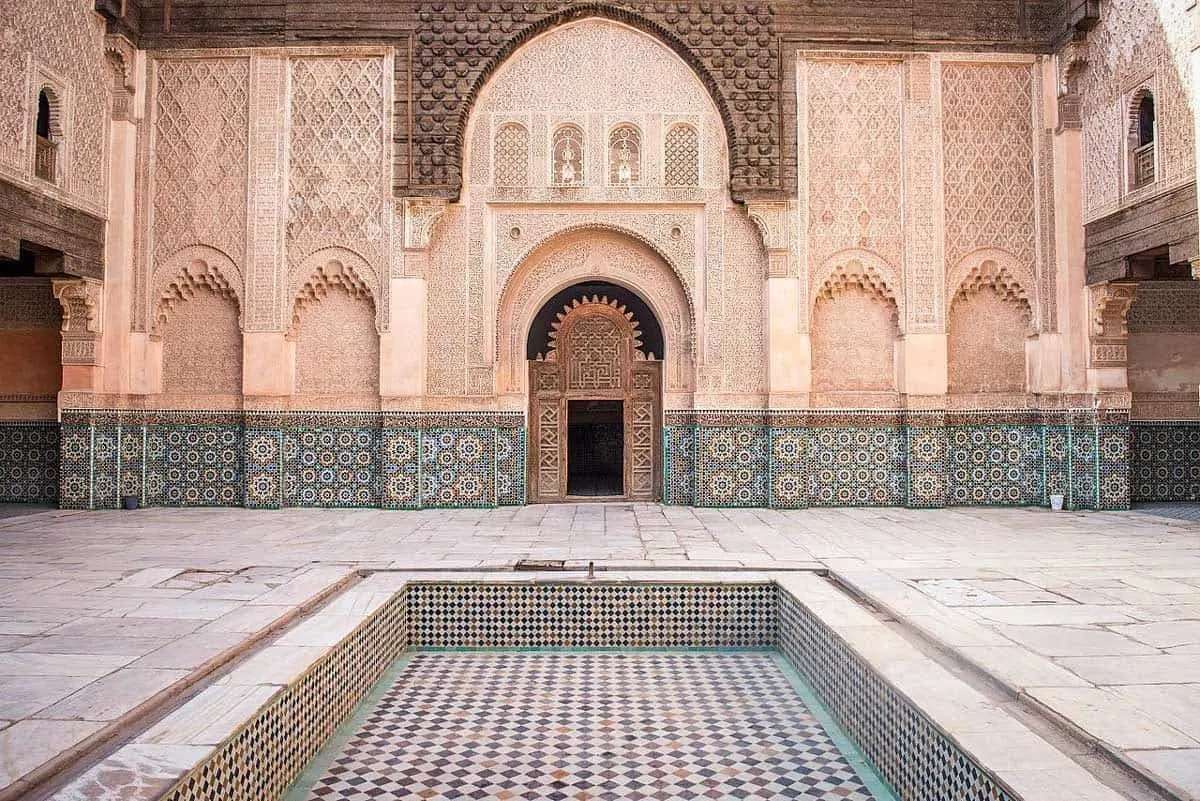
El Badi Palace
“Incomparable Palace” is the rough translation for El Badi Palace. Commissioned by the Saadian Sultan Ahmad el Mansour towards the end of the 16th century the palace was indeed the most magnificent structure in the city.
Having been stripped of all its value and beauty by the sultan’s successor, the palace is now not much more than a magnificent ruin, yet it remains one of the most famous sights in Marrakech.
While the El Badi Palace is a shell of its former grandeur, the ruins are vast, so the sheer scale of the former palace is in itself a wonder.
Allow yourself at least an hour or two to take in the size of the grounds. You will also get some lovely views of the city of Marrakech.
Located to the south of the Marrakesh medina about a 15-minute walk from Koutoubia mosque or a 5-10 minute walk from the Saadian Tombs.
- El Badi Palace Opening Hours: Daily: 8 am – 5 pm
- Entry: 10 DH pp | Additional 10 DH pp to enter the museum that houses the Koutoubia Mosque pulpit.
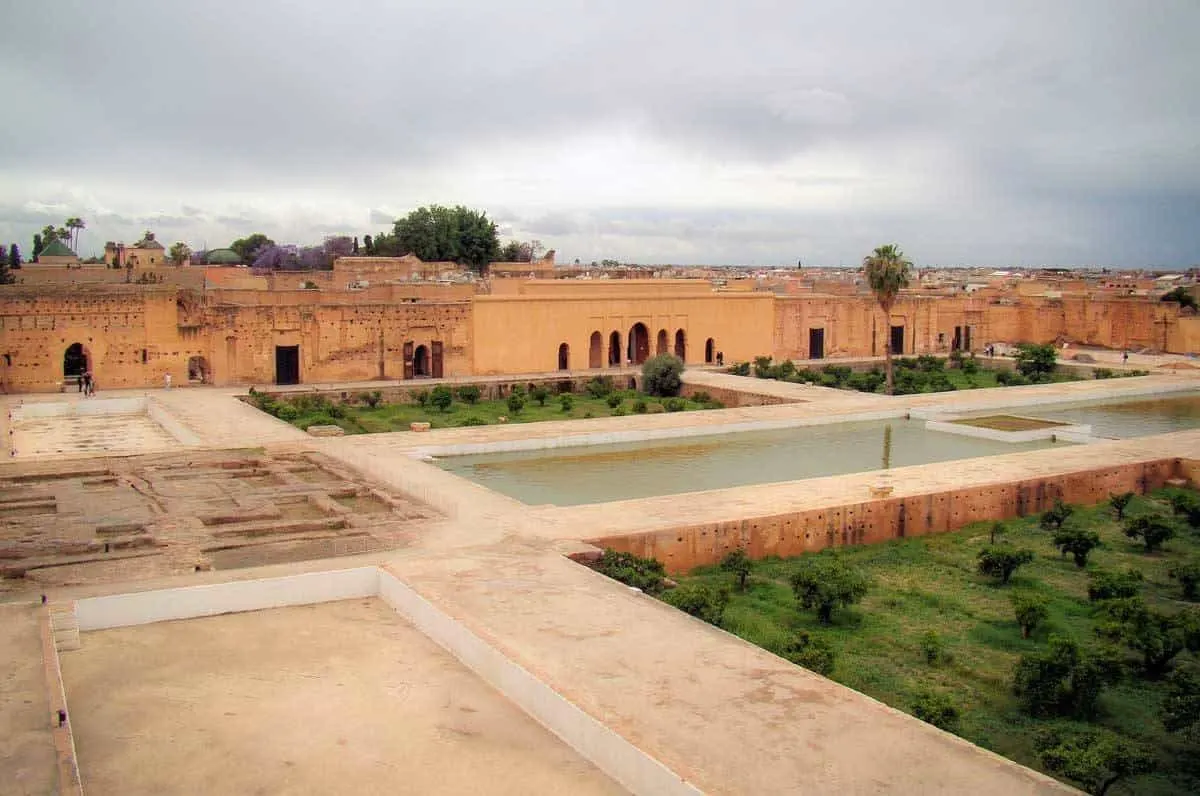
The Bahia Palace
Commissioned by the Grand Vizier Ba Ahmed ben Moussa in the late 19th century, the Palace of Bahia was intended to be the most impressive palace of all time. And herein lies the translation – “brilliance, palace of the beautiful, the brilliant”.
The palace was designed in two stages and took over ten years to complete. Craftsmen from all over the country were bought to work on the building which eventually comprised of 150 rooms overlooking various patios and gardens, and a harem for Abu Bou Ahmed’s four wives and 24 concubines.
Located on eight hectares, the palace is a masterpiece of Moroccan architecture. A monument of the country’s cultural heritage and one of the most popular tourist attractions in Morocco.
When the vizier died, all of the artwork and furnishings were taken by his wives and the sultan leaving the palace empty. Even as a vacant building, the Bahia Palace is still a spectacular sight.
- Bahia Palace Opening Hours: Daily: 9 am – 5 pm ( times may vary on a Friday)
- Entry: 10 DH
